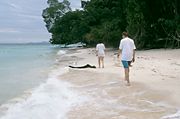|
|
|
| |
|
| Dive safari |
|
From Bario we flew back to Miri and then on to Kota Kinabalu and Tawau, where a person from a dive safari agency picked us up. After staying a night in Semporna, we boarded a boat for a three-day journey to paradise. Our best memories are from the famous Sipadan island. Although a bit crowded and a visibility that suffered from a recent storm the diving was great, with lots of fish and green giant turtles. | |

|
347. Paradise island 
The sea outside Semporna is dotted with tropical islands. We left in the morning and made our first two dives at the nearby island Palau Mabul. Since we were not staying overnight, we were not allowed to go ashore. In the afternoon, we continued to Roach Reef. It is a man-made island built on a small sandbank. The atmosphere was friendly and relaxed and it was certainly not crowded here. Since we spent the night there, we had time for a night dive. The next day we continued to Palau Sipadan, the most known island (among divers) in the region. Sipadan lies far out into the sea with a surrounding depth of 600 metres. Just outside the dive centre is a more or less vertical wall down to the bottom! |

|
381. Green turtles The sea around Sipadan was crowded with green turtles. We saw the first one after just a few minutes of our first dive. Soon, we didn't bother counting them. It was strictly forbidden to touch the turtles as well as any other fish or corals. At night, the turtles come up on the beach to lay eggs. Because of this, it was also forbidden to go outside the hotel area after 6 pm, except if you were part of a guided tour. We were unlucky; the man guiding on the tours was going on vacation the same day as we arrived. |

|
396. Butterfly fish There were also a lot of fish around Sipadan. Some came in large schools like the butterfly fish or barracudas. Others were lone warriors like the reef sharks. No matter where one turned it was a colourful display. Suddenly, all of the smaller fish would swim into the reef for shelter leaving the space around us totally empty! We couldn't see anything, but something must have scared them. After a few seconds, they were coming out again, one kind after the other, creating colourful, layered bands of different species. |

|
404. Inspecting the coral The corals had seen their best days. If it was because of global warming or the sheer number of divers (Sipadan can host over 100 divers doing four or five dives every day) was hard to tell. Probably it was a little of both. During the night, the reef was entirely different. We were diving along the wall just outside the dive centre and all corals had put their red tentacles out. It was a great show, with big parrotfish looming around over and below, and the flashlights from other divers further away creating a spectacular light. |

|
425. School of barracudas It was our last dive at Sipadan. My girlfriend and I stayed rather shallow to take some pictures while the rest of the group went deeper in pursuit of some barracudas. The current was heavy in some places, but we could handle it by going to another depth, where the current was going the other way! At the end of the dive, the divemaster signalled to us. Around a corner, there was suddenly a large school of barracudas. It was like a wall in front of us, stretching into to the blue as far as one could see in all directions. Magnificent! It became the subject of the day among the rest of the divers on the island. It was a rare event that such a large school was spotted. |
|
|
|
| © 2001-2002 • Photos Nicklas Nordborg and Dimitria Kallini • Texts and sounds Nicklas Nordborg |